在Pandas Dataframe中把负值标为红色,正值标为黑色
让我们看看在Pandas Dataframe中突出正值为红色,负值为黑色的各种方法。
首先,让我们做一个Dataframe。
# Import Required Libraries
import pandas as pd
import numpy as np
# Create a dictionary for the dataframe
dict = {
'Name': ['Sukritin', 'Sumit Tyagi',
'Akriti Goel', 'Sanskriti',
'Abhishek Jain'],
'Age': [22, 20, 45, 21, 22],
'Marks': [90, 84, -33, -87, 82]
}
# Converting Dictionary to
# Pandas Dataframe
df = pd.DataFrame(dict)
# Print Dataframe
print(df)
输出:
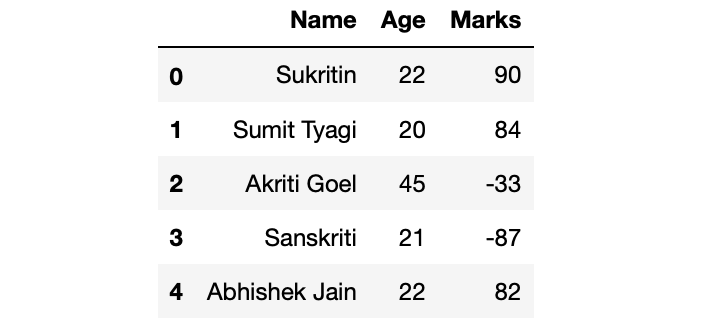
现在,来看看突出显示的部分。我们的目标是将负值标为红色,正值标为黑色。
方法1:使用Dataframe.style.apply()。
语法: DataFrame.style.apply(self, func, axis=0, subset=None, **kwargs)
参数:
- func: 它应该接收一个基于axis的pandas.Series或pandas.DataFrame,并应该返回一个具有相同形状的对象。
- axis: {0或’索引’,1或’列’,无},默认为0。适用于每一列(axis=0或’index’),适用于每一行(axis=1或’columns’),或者用axis=None一次适用于整个DataFrame。
- subset: 你想在其中调用函数的列或行的集合。
- kwargs: 传递给func。
例子1:突出显示文本。
# Define a function for colouring
# negative values red and
# positive values black
def highlight_max(s):
if s.dtype == np.object:
is_neg = [False for _ in range(s.shape[0])]
else:
is_neg = s < 0
return ['color: red;' if cell else 'color:black'
for cell in is_neg]
# Using apply method of style
# attribute of Pandas DataFrame
df.style.apply(highlight_max)
输出:
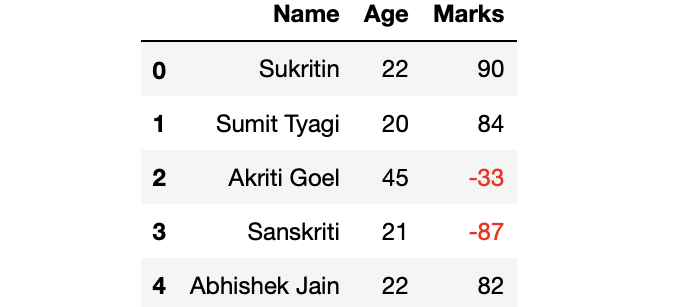
例子2:突出显示单元格而不是文本。
# Define a function which
# returns the list for
# df.style.apply() method
def highlight_max(s):
if s.dtype == np.object:
is_neg = [False for _ in range(s.shape[0])]
else:
is_neg = s < 0
return ['background: red; color:white'
if cell else 'background:black; color:white'
for cell in is_neg]
# Using apply method of style
# attribute of Pandas DataFrame
df.style.apply(highlight_max)
输出:
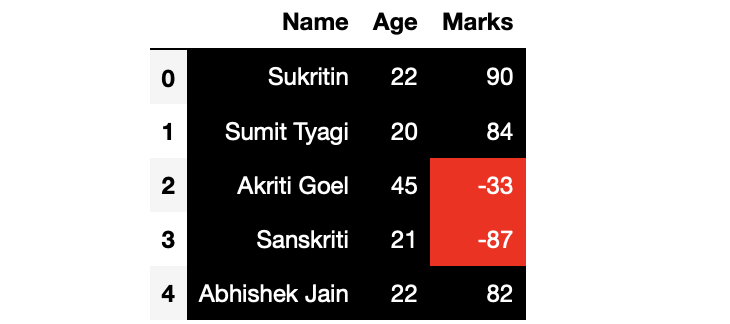
方法2:使用dataframe.style.applymap()方法。
语法: DataFrame.style.applymap(self, func, subset=None, **kwargs)
参数:
- func: 它接收一个标量值并返回标量值
- subset: 你想调用该函数的列或行的集合。
- **kwargs: 传递给func。
返回值: Styler对象。
例子1:突出显示文本。
# Define a function for
# colouring negative values
# red and positive values black
def highlight_max(cell):
if type(cell) != str and cell < 0 :
return 'color: red'
else:
return 'color: black'
df.style.applymap(highlight_max)
输出:
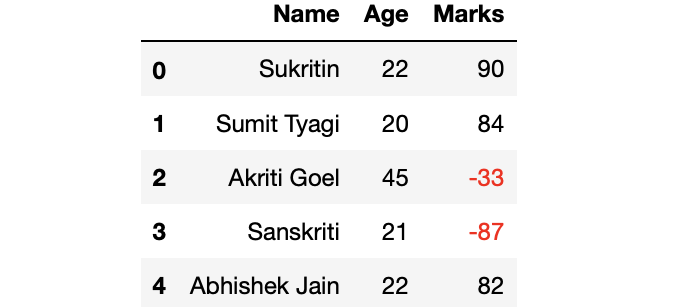
例子2:突出显示单元格而不是文本。
# Define a function which
# returns string for
# applymap() method
def highlight_max(cell):
if type(cell) != str and cell < 0 :
return 'background: red; color:black'
else:
return 'background: black; color: white'
df.style.applymap(highlight_max)
输出:
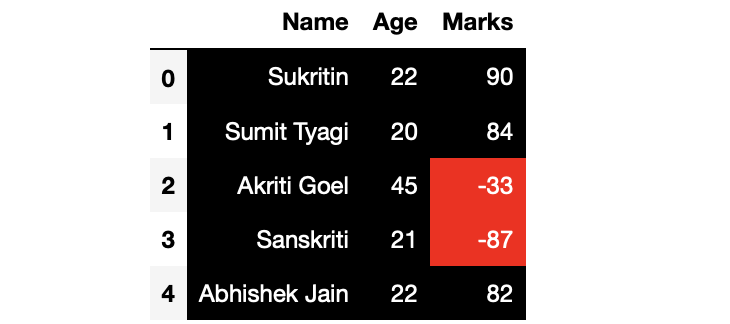
注意: pandas.DataFrame.applymap()方法只将单个单元格传递给可调用函数,而pandas.DataFrame.apply()则将pandas.Series传递给可调用函数。
 极客教程
极客教程